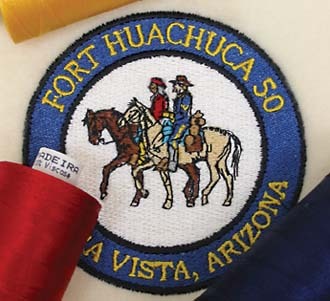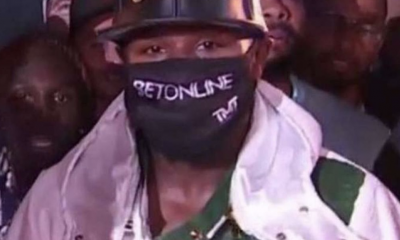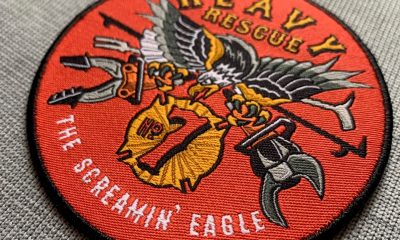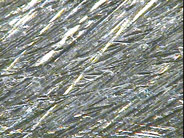Embroidery
Published
17 years agoon

The decision to add embroidery to your screen-printing shop is a big one. Selecting the right equipmentis critical, but it's also very important to make thread inventory a priority as well. Many machine manufacturers supply starter kits of threads that they believe run well on their systems. However, when you consider the size of the investment you've made, you'll find it pays to investigate the variety of threads on the market and test them on your embroidery machine to help you decide the best way to stock your supply shelves. This article will discuss the most common types of thread materials, reveal some of the options available in specialty threads, and define some of the basic terminology that will help you become more supply savvy.
Thread materials
The embroidery field basically breaks into two camps when it comes to thread: rayon and polyester. Each has its own characteristics, its own following, and its own strengths when it comes to end use. Each is offered in various thicknesses, or weights.
The standard weight for general use is #40, or 40 weight, and the thread is available on 1100-yard spools and 5500-yard cones. Other weights, which serve more specific purposes, are #12, #30 and #60. For example, 60-weight thread (Figure 1), which is available in rayon and polyester, can provide detail to a design that otherwise would be impossible to achieve. Also consider #60 for small lettering. If you were to compare a stitch-out of an emblem where lettering circles the design in 40 weight vs. 60, the clarity and definition obvious in the 60-weight stitch-out would impress your client.
Roughly 80% of embroiderers throughout the world use rayon. The material is made of 100% cellulose, which started life as a tree, and can be considered a natural fiber. Many artistic embroiderers choose rayon because it is a soft, pliable fiber that—like fine fabrics—has a nice hand and will take easily to intricate designs. It comes in a multitude of colors, and some manufacturers offer rayon threads that are matched to colors in the Pantone ink system.
A rayon thread of good quality can be run at more than 1000 stitches/min with no thread breaks in simple designs and is colorfast in wash temperatures of up to 203° F. The 30-weight rayon thread is approximately 50% thicker than rayon #40 and can be used to save on stitches when filling in larger areas. Rayon in 12 weight is the thickest thread available. It's used for fancy outline stitches, special effects, and for serging (finishing).
Polyester is the thread of choice for embroiderers who base their purchasing decisions on cost alone. Polyester thread, which consists of 100% polyester filament, is a less expensive thread than rayon. Polyester is available on 1100-yard spools and 5500-yard cones, and it offers greater tensile strength (the force it can endure before breakage occurs) than rayon. In fact, its strength can be unforgiving when it comes to an intricate design, so tension on the machine will have to be adjusted accordingly. The most significant property of polyester thread is that it can withstand heavy-duty laundering, even in wash water that contains bleach. Polyester thread is available in many colors, and some manufacturers offer Pantone-matched threads. A 60-weight polyester is about 60% thinner than the general use #40 and is used for embroidering small lettering for monograms and for small or fine details. This finer thread provides clarity and definition to a properly digitized design.
Thread is a commodity that can work for or against you. Don't skimp on quality. You want your machines to run at optimum speed, which means minimizing the number of thread breaks. When you factor the time it takes to fix thread that is not running properly, rethread the machine, reposition the garment, and cue up the machine again, you're looking at an accumulation of operator hours that you are paying for while gaining nothing.
Specialty threads add value
Keeping ahead of the competition is as important in the embroidery industry as in any other, and one way to do it is to master specialty threads (Figure 2). Bringing the wow factor to your customers is probably the best way to maintain your lead. Working with these threads requires some patience, practice, and perseverance. Manufacturers can suggest which needle to use and which backing or topping will enhance the appearance of the decorated garment.
Most specialty threads lend themselves well to any substrate, providing it is not very sheer or delicate. In those cases, selecting the appropriate needle size for the job will often deliver good results. When in doubt, a test run, and/or checking with the manufacturer, will ensure success. Many specialty threads are available on the market today. Some follow fashion trends, while others set them. Some fulfill the specific needs of a market niche; others can be used to create a niche of their own. Here's a look at some of your options:
Wool blends are wool/acrylic threads that use their thickness and appearance to give designs a hand-embroidered look. Use a #100/16 needle and lighten the tension on your machine.
Twisted metallics consist of metallized polyester wrapped around a polyester core. They require a design with less density and the use of a larger needle (#90/14). These threads work best when the machine is slowed to 650-800 stitches/min.
Smooth metallics are made up of a variety of combinations of metallized polyester wrapped on a polyester or rayon core. They come in many different weights and colors and in cones and spools. Put-up and needle requirements may vary by thread weight. Metallic embroidery has enjoyed a popular run in fashion lately.
Soft metallics are very shiny, 100%-polyester threads. They can be used in place of metallic threads on children's wear or lingerie, where the softness of the back side of the embroidery, which comes in contact with the skin, is a concern.
Fire-resistant thread is made of 100% Aramid fiber. It's heat- and flame-resistant, complies with ISO stan-dards (ISO-6941 and ISO-15025), and is intended for markets such as fire and safety, auto racing, aeronautics, and petrochemicals.
Glow-in-the-dark threads offer a novel way to apply special effects on children's wear or sweatshirts. Use a #75/11 needle for best results. Providing your customers with sample stitch-outs of the specialty threads you use is the surest way to secure sales and substantiate your reasons for charging more for the product, should you choose to do so. For convenience, maintain a samples book that allows you to slide your specialty stitch-outs in and out of plastic sleeves.
The one-stop shop
Customers must know that you're able to fulfill all aspects of their decorated-apparel needs, whether the clients are in your shop, on the phone with your sales team, or visiting your Website. Demonstrating your abilities to offer a complete package will enable you to lure new customers and sell additional services to existing accounts. You can reinforce that image by keeping shipping costs down and handling fees low, carefully controlling inventory, assuring the best prices for volume work, decreasing turnaround time, and streamlining information management.
A great deal of the new business for which screen printers compete comes from word-of-mouth referrals. Keeping customers aware of the value-added work you're capable of offering is critical to your success. Ultimately, developing the reputation for reliable, personal service, will win not only your customers' business, but their loyalty as well.
About the author
Hajo Voeller is president of Madeira USA, Laconia, NH. He uses his many years of executive experience in sales and marketing to enhance Madeira's worldwide presence, secure greater market share, and expand the company's product portfolio. A native of Munich, Germany, Voeller most recently launched a new Madeira business division, E-Zee Backing & Topping.

Subscribe

Magazine
Get the most important news
and business ideas from Screenprinting Magazine.
Most Popular
-

 Case Studies2 months ago
Case Studies2 months agoHigh-Density Inks Help Specialty Printing Take Center Stage
-

 Art, Ad, or Alchemy2 months ago
Art, Ad, or Alchemy2 months agoF&I Printing Is Everywhere!
-

 Andy MacDougall2 months ago
Andy MacDougall2 months agoFunctional and Industrial Printing is EVERYWHERE!
-

 Columns3 weeks ago
Columns3 weeks ago8 Marketing Mistakes Not to Make When Promoting Your Screen Printing Services Online
-

 Editor's Note2 weeks ago
Editor's Note2 weeks agoLivin’ the High Life
-

 Marshall Atkinson2 weeks ago
Marshall Atkinson2 weeks agoHow to Create a Winning Culture in Your Screen-Printing Business
-

 Thomas Trimingham2 months ago
Thomas Trimingham2 months ago“Magic” Marketing for Screen Printing Shops
-

 News & Trends2 months ago
News & Trends2 months agoWhat Are ZALPHAS and How Can You Serve Them in Your Print Business?






